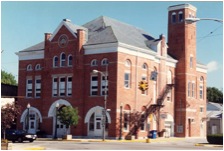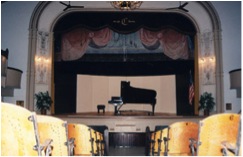Cedarville

Current Name of Theater: Cedarville Opera House
Current Use : music and theater venue
Seats: 500
Website: cedarvilleoperahouse.org
Historic Names of Theater: Cedarville Opera House
Address: 70 North Main Street
Cedarville, Ohio 45314
Year Built: 1888
Original Architect:
Original Cost:
Listed on National Register: yes
National Register Reference Number: 84003697
National Register Listing Date: 02/09/1984
Historic Use(s): Correctional Facility,: Fire Station, Library, Theater
Current Use(s): Correctional Facility, Library, Theater

History of Theater: Built of brick with elements of stone, the opera house is a Romanesque Revival structure that has served a wide range of purposes in the community. Besides its primary function as a home for the performing arts, the two-and-a-half-story building has housed the offices of Cedarville’s mayor and village council, its jail, its fire and police departments, its waterworks, and its library, as well as the township trustees’ office for Cedarville Township. When Cedarville’s was built, the opera house as an institution was a center of social life in rural Ohio: the public sphere was nearly nonexistent except for the village opera house, which typically served as a meeting place for travelling vaudeville acts, political events, musical performances, and graduation ceremonies. Because the first floor has always been used as offices for the various organizations that used the building, public events were typically held on the second floor, which has been little modified by the years; it is one of Ohio’s least changed historic performance halls.
Early History
The original frame of the Cedarville Opera House was constructed in 1886 only to be destroyed by fire within the year. The architectural plans for the current brick Opera House, built in 1888, were brought to Cedarville from England by Cedarville native Whitelaw Reid. Whitelaw Reid was a noted publisher and US Ambassador to England and France and his portrait hangs above the Opera House stage. The design of the Opera House is a 1/3 scale model of the Royal Albert Hall in London. Hohn W. McLean of Cedarville built the structure.
In the late 1800s, the Pennsylvania Railroad, which ran through Cedarville, made the construction of an Opera House a logical step for a growing town. Over the next 60 years, the Cedarville Opera House became the center of community life, opening its doors to minstrel and medicine shows, touring drama groups, orators, political rallies, magic lantern shows, and high school and college graduations and programs.
Due to the advances in transportation and accessibility to outside entertainment, the Opera House closed its doors in 1956 and remained unused except by bats and pigeons for nearly 30 years.
The Cedarville Opera House was originally constructed in 1886 and became the center of community life for over 60 years. It hosted many musical, educational, theatrical, and even political programs. In 1956, because of greater accessibility and interest in outside entertainment, the Opera House closed its doors and was not used for the next 30 years. In the early 1980s, citizens took a revived interest in the opera house and, in 1984, the Cedarville Opera House was placed on the Historic Preservation Commission of Cedarville. Citizens helped restore and rebuild the buiding, and in 1994 the Cedarville Opera House reopened. The following year, the Cedarville Opera House Society was formed. Since then, a full array of programs including music, theater, and literary recitals have been held for the enjoyment of the public.
Cost of Rehabilitation:
Architect:
Contractors:
Source of Funds:
Renovation story:
When it was discovered that one of the main beams was deteriorating and demolition became a possibility, a new interest in the old structure began to emerge. In the early 1980s, concerned citizens banded together and the Historic Preservation Commission of Cedarville, Inc. (HPCC) was born.
Through the concerted efforts of the HPCC and the Cedarville Township Trustees, a levy for the restoration of the opera house was placed on the ballot. With the passage of this levy, restoration began.
The first step of the cleaning and repairing process was to remove tons of droppings. Holes in the ceiling were then repaired, the ceiling beam reinforced, the slate roof restored, and the chimney and bell tower repaired.
In 1984, the Opera House was placed on the Historic Preservation Commission of Cedarville.
![]()

